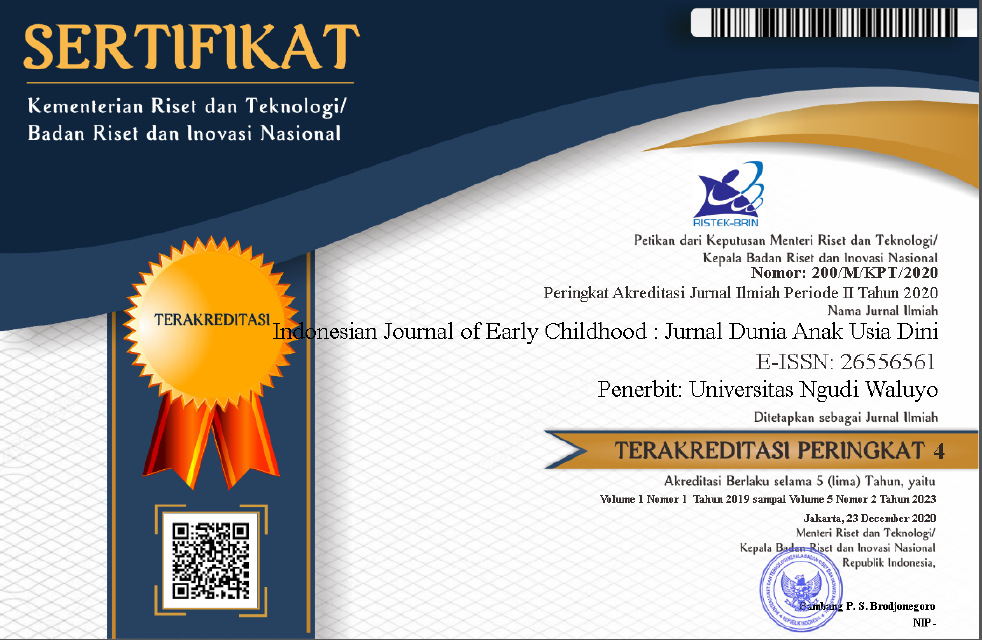Implementasi Pendidikan Seks terhadap Perilaku Anak dalam Bergabung dengan Sesama Berbasis Video Animasi
Implementation Of Sex Education On Children's Behavior In Associating With Peers Based On Animation Videos
DOI:
https://doi.org/10.35473/ijec.v6i1.2961Keywords:
Pendidikan Seks;Perilaku Anak; Pergaulan dengan Teman Sebaya; Video AnimasiAbstract
It is necessary to introduce the concept of sex education to children from an early age because this is the basis for children interacting with peers. Sex education in society is usually a taboo subject, but actually it is no longer taboo and needs to be introduced clearly. There are many methods that parents can use. In this study, researchers implemented an introduction to the concept of sex education to children through animated video services. This is because children tend to like things that move and make sounds, such as films or videos, compared to just visualization shows such as story books. This type of research uses qualitative research with a case study approach. The case study is a model that focuses on exploring "limited systems" in particular by extracting detailed and in-depth data. Information obtained from various sources to obtain the desired data. The research was conducted at Kindergarten IB 68, Sungai Rumbai District, Dharmasraya Regency, West Sumatra Province with a research time of 3 months starting from January to March 2023. The subjects in the study were children with an age range of 5-6 years who were selected through a purposive sampling technique. The data analysis techniques used are observation and interviews. The results of the research show that the use of animated videos has an influence on differences in children's behavior in interacting with peers. In this case, the video shown to children is not only shown once but is done several times and observations are made to see the effect on the child's behavior in socializing with peers.
ABSTRAK
Konsep pendidikan seks pada anak perlu diperkenalkan sejak dini karena hal ini menjadi landasan anak dalam berinteraksi dengan teman sebayanya. Pendidikan seks di masyarakat biasanya merupakan hal yang tabu, namun sebenarnya sudah tidak tabu lagi dan perlu diperkenalkan secara jelas. Ada banyak cara yang bisa digunakan orang tua. Pada penelitian ini peneliti menerapkan pengenalan konsep pendidikan seks pada anak melalui layanan video animasi. Pasalnya, anak cenderung menyukai benda-benda yang bergerak dan mengeluarkan suara, seperti film atau video, dibandingkan hanya tayangan visualisasi seperti buku cerita. Jenis penelitian ini menggunakan penelitian kualitatif dengan pendekatan studi kasus. Studi kasus merupakan model yang berfokus pada eksplorasi “sistem terbatas” khususnya dengan mengekstraksi data secara detail dan mendalam. Informasi diperoleh dari berbagai sumber untuk memperoleh data yang diinginkan. Penelitian dilaksanakan di TK IB 68 Kecamatan Sungai Rumbai Kabupaten Dharmasraya Provinsi Sumatera Barat dengan waktu penelitian selama 3 bulan terhitung pada bulan Januari sampai dengan Maret 2023. Subyek dalam penelitian adalah anak dengan rentang usia 5-6 tahun yang dipilih melalui teknik purposive sampling. Teknik analisis data yang digunakan adalah observasi dan wawancara. Hasil penelitian menunjukkan bahwa penggunaan video animasi memberikan pengaruh terhadap perbedaan perilaku anak dalam berinteraksi dengan teman sebaya yaitu anak sudah mulai memahami batasan bersosialisasi dengan teman sebayanya di lingkungan sekitar. Dalam hal ini video yang ditayangkan kepada anak tidak hanya ditayangkan satu kali saja melainkan dilakukan beberapa kali dan dilakukan observasi untuk melihat pengaruhnya terhadap perilaku anak dalam bersosialisasi dengan teman sebayanya. Berdasarkan dari penelitian yang telah dilakukan peneliti merekomendasikan kegiatan ini kepada guru atau semua lapisan praktisi Pendidikan untuk dapat mengenalkan hal terutama mengenai Pendidikan seks salah satunya dapat menggunakan video animasi. Adapun implikasi dari penelitian ini yaitu hasil penelitian dapat dijadikan sebagai referensi dalam mengenalkan konsep Pendidikan seks kepada anak. Hasil penelitian dan kelemahan penelitian dapat dijadikan pedoman bagi peneliti selanjutnya dalam melakukan penelitian yang memiliki tema yang sama.
References
Ayling, N. J., Walsh, K., & Williams, K. E. (2020). Factors influencing early childhood education and care educators’ reporting of child abuse and neglect. Australasian Journal of Early Childhood, 45(1), 95–108. https://doi.org/10.1177/1836939119885307
Bus, A. G., Neuman, S. B., & Roskos, K. (2020). Screens, Apps, and Digital Books for Young Children: The Promise of Multimedia. AERA Open, 6(1), 233285842090149. https://doi.org/10.1177/2332858420901494
Chang, C. J., Lo, C. O., & Chuang, S. C. (2020). Applying Video Modeling to Promote the Handwriting Accuracy of Students with Low Vision Using Mobile Technology. Journal of Visual Impairment and Blindness, 114(5), 406–420. https://doi.org/10.1177/0145482X20953269
Febriagivary, A. H. (2021). Mengenalkan Pendidikan Seksualitas Untuk Anak Usia Dini Melalui Metode Bernyanyi. Children Advisory Research and Education Jurnal CARE, 8(2), 11–20.
Fitriani, D., Fajriah, H., & Wardani, A. (2021). Mengenalkan Pendidikan Seks Pada Anak Usia Dini Melalui Buku Lift the Flap “Auratku.” Gender Equality: International Journal of Child and Gender Studies, 7(1), 33. https://doi.org/10.22373/equality.v7i1.8683
Flores, D. D., Rosario, A. A., Bond, K. T., Villarruel, A. M., & Bauermeister, J. A. (2020). Parents ASSIST (Advancing Supportive and Sexuality-Inclusive Sex Talks): Iterative Development of a Sex Communication Video Series for Parents of Gay, Bisexual, and Queer Male Adolescents. Journal of Family Nursing. https://doi.org/10.1177/1074840719897905
Haryono, S. E., Anggareni, H., Muntomimah, S., & Iswahyudi, D. (2018). Impelementasi pendididkan sex pada anak usia dini di sekolah. JAPI (Jurnal Akses Pengabdian Indonesia), 3(1), 24. https://doi.org/10.33366/japi.v3i1.839
Hewett, K. J. E., Zeng, G., & Pletcher, B. C. (2020). The Acquisition of 21st-Century Skills Through Video Games: Minecraft Design Process Models and Their Web of Class Roles. Simulation and Gaming, 51(3), 336–364. https://doi.org/10.1177/1046878120904976
Ismiulya, F., Diana, R. R., Na’imah, N., Nurhayati, S., Sari, N., & Nurma, N. (2022). Analisis Pengenalan Edukasi Seks pada Anak Usia Dini. Jurnal Obsesi : Jurnal Pendidikan Anak Usia Dini, 6(5), 4276–4286. https://doi.org/10.31004/obsesi.v6i5.2582
Jatmikowati et al. (2015). a Model and Material of Sex Education for Early-Aged-Children. Tri Endang Jatmikowati,Ria Angin, Ernawati, No. 03, 434–448.
Karni-Visel, Y., Hershkowitz, I., Lamb, M. E., & Blasbalg, U. (2021). Nonverbal Emotions While Disclosing Child Abuse: The Role of Interviewer Support. Child Maltreatment, 28(1), 66–75. https://doi.org/10.1177/10775595211063497
Mantilla, A., & Edwards, S. (2019). Digital technology use by and with young children: A systematic review for the Statement on Young Children and Digital Technologies. Australasian Journal of Early Childhood. https://doi.org/10.1177/1836939119832744
Nurhusni Kamil, E. A. H. (2023). Implementation of STEAM in Preschool as a 21st-Century Learning Innovation. 3(1), 54–65. https://doi.org/10.14421/joyced.2023.31-06
Nurhusni Kamil, H. (2023). Analisis Metode Scaffolding pada Pembelajaran di PAUD. Jurnal Educhild (Pendidikan Dan Sosial), 12(2), 34–39.
Purwasih, W. (2022). Pendidikan Seks Pada Anak Usia Dini Di Paud Aisyiyah Cabang Kartasura. BUANA GENDER : Jurnal Studi Gender Dan Anak, 3(2). https://doi.org/10.22515/bg.v3i2.4920
Riney, L., Frey, T., Fain, E., Duma, E., & Chambers, P. (2020). Improving Communication With Families for Evaluation of Child Abuse. Journal of Patient Experience, 7(6), 827–829. https://doi.org/10.1177/2374373520950987
Spoyalo, K., Courtemanche, R. J. M., & Henkelman, E. (2020). Online Cleft Educational Videos: Parent Preferences. Cleft Palate-Craniofacial Journal. https://doi.org/10.1177/1055665620957215
Suhasmi, N. C., & Ismet, S. (2021). Materi Pendidikan Seks Bagi Anak Usia Dini. Jurnal Golden Age, Universitas Hamzanwadi, 5(02), 164–174.
Downloads
Published
How to Cite
Issue
Section
License
Copyright (c) 2024 Indonesian Journal of Early Childhood: Jurnal Dunia Anak Usia Dini

This work is licensed under a Creative Commons Attribution-ShareAlike 4.0 International License.
Please find the rights and licenses in Indonesian Journal Of Early Childhood: Jurnal Dunia Anak Usia DIni. By submitting the article/manuscript of the article, the author(s) agree with this policy. No specific document sign-off is required.
1. License
The non-commercial use of the article will be governed by the Creative Commons Attribution license as currently displayed on Creative Commons Attribution-ShareAlike 4.0 International License.
2. Author(s)' Warranties
The author warrants that the article is original, written by stated author(s), has not been published before, contains no unlawful statements, does not infringe the rights of others, is subject to copyright that is vested exclusively in the author and free of any third party rights, and that any necessary written permissions to quote from other sources have been obtained by the author(s).
3. User Rights
Indonesian Journal Of Early Childhood: Jurnal Dunia Anak Usia Dini's spirit is to disseminate articles published are as free as possible. Under the Creative Commons license, Indonesian Journal Of Early Childhood: Jurnal Dunia Anak Usia Dini permits users to copy, distribute, display, and perform the work for non-commercial purposes only. Users will also need to attribute authors and Indonesian Journal Of Early Childhood: Jurnal Dunia Anak Usia Dini on distributing works in the journal and other media of publications.
4. Co-Authorship
If the article was jointly prepared by more than one author, any authors submitting the manuscript warrants that he/she has been authorized by all co-authors to be agreed on this copyright and license notice (agreement) on their behalf, and agrees to inform his/her co-authors of the terms of this policy. Indonesian Journal Of Early Childhood: Jurnal Dunia Anak Usia Dini will not be held liable for anything that may arise due to the author(s) internal dispute. Indonesian Journal Of Early Childhood: Jurnal Dunia Anak Usia Dini will only communicate with the corresponding author.
5. Miscellaneous
Indonesian Journal Of Early Childhood: Jurnal Dunia Anak Usia Dini will publish the article (or have it published) in the journal if the article’s editorial process is successfully completed. Indonesian Journal Of Early Childhood: Jurnal Dunia Anak Usia Dini's editors may modify the article to a style of punctuation, spelling, capitalization, referencing and usage that deems appropriate. The author acknowledges that the article may be published so that it will be publicly accessible and such access will be free of charge for the readers as mentioned in point 3.
Â
Every accepted manuscript should be accompanied by "Copyright Transfer Agreement" prior to the article publication.



